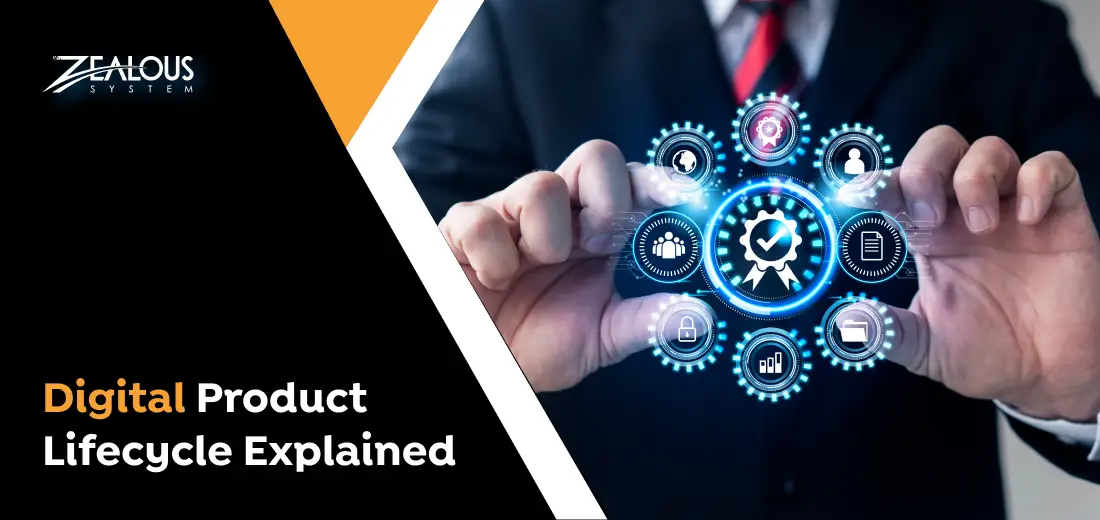
We use cookies and similar technologies that are necessary to operate the website. Additional cookies are used to perform analysis of website usage. please read our Privacy Policy
Digital Product Lifecycle: Definition, Phases, Best Practices

As digital products become more popular and competitive, product managers need a plan to handle their products’ lifecycles. This means regularly updating and improving the product using user feedback, research, and market trends to keep it competitive, relevant, and profitable.
Building and managing digital products effectively is crucial for businesses to stay competitive. From apps and websites to complex software solutions, digital products drive much of the innovation and value in the modern economy. However, developing a digital product is not a one-time effort.
It involves a continuous process of planning, development, testing, deployment, and maintenance, all of which are part of what is known as the digital product lifecycle.
Understanding the digital product lifecycle is essential for ensuring that products not only meet market needs at launch but also continue to deliver value over time. This lifecycle encompasses various stages, each requiring specific strategies and best practices to navigate successfully.
This ultimate guide will explore the digital product lifecycle in detail, breaking down each phase and highlighting the best practices for managing the process effectively. By understanding and applying these principles, you can ensure your digital product remains relevant, efficient, and user-friendly throughout its life.
What is the Digital Product Lifecycle?
The digital product lifecycle refers to the entire process a digital product undergoes from conception to retirement. It includes all the stages a product goes through, from initial idea generation and development to its eventual decline and phase-out.
This lifecycle is crucial for managing a product’s progression and ensuring it adapts to changing market demands and technologies trends.
At its core, the digital product lifecycle helps businesses plan and execute strategies that maximize product value and minimize risks. By understanding the different phases and their unique challenges, teams can better prepare for each stage and implement processes that ensure the product evolves in line with user needs and market trends.
This holistic approach helps in delivering a product that not only meets current demands but also adapts and grows with time.
What are the Phases of Digital Product Development?

Digital product development typically involves several phases that help in conceptualizing, designing, building, and launching a product. These phases can vary slightly depending on the methodology and specific product, but generally include:
1. Strategy and Conceptualization
This is the first phase where the idea for the digital product is formed. It involves understanding market needs, identifying target users, and defining the product’s goals and objectives. During this phase, product managers and stakeholders create a clear strategy and vision for the product, which guides all subsequent phases.
- Idea Generation: This initial phase involves brainstorming and identifying potential product ideas based on market research, user feedback, and technological trends.
- Feasibility Analysis: Assess the viability of the ideas considering technical, financial, and market feasibility.
- Concept Development: Refine the chosen idea into a detailed concept, outlining the product’s features, target audience, and value proposition.
2. Product Design
In this phase, the focus is on designing the user experience and interface of the product. This involves creating wireframes, prototypes, and mockups to visualize the product. User feedback is often gathered to refine the design. The goal is to create a user-friendly and visually appealing product that meets the needs identified in the strategy phase.
- Requirement Gathering: Collect and document detailed requirements from stakeholders and potential users.
- Prototyping: Create wireframes and prototypes to visualize the product’s design and functionality.
- Design: Develop the UI/UX design, focusing on creating an intuitive and engaging user experience by using latest design trends.
3. Product Development
During the digital product development phase, the design is turned into a working product. Developers write code, integrate various features, and perform initial testing. There should be proper collaboration between designers, developers, and product managers which ensure the product aligns with the original vision and functions as intended.
- Coding: Write the code to develop the product, adhering to the specifications and designs.
- Integration: Ensure all components and third-party services are integrated with the product seamlessly.
- Testing: Conduct various tests (unit, integration, system) to identify and fix bugs.
4. Product Launch
Once the product is developed and tested, it is ready to be launched to the market. This phase involves planning and executing marketing strategies, preparing support teams, and ensuring the product is available to users. The launch phase aims to create awareness, attract users, and generate initial feedback.
5. Product Growth
After the product is launched, the focus shifts to growing the user base and increasing engagement. This phase involves ongoing marketing efforts, user acquisition strategies, and enhancements based on user feedback. The goal is to establish a strong user base and ensure the product meets evolving user needs.
6. Product Evolution
In the product evolution phase, continuous improvements and updates are made to keep the product competitive and relevant. This includes adding new features, fixing bugs, and adapting to market changes. Product managers use data and user feedback to guide these updates, ensuring the product remains valuable to users over time.
Best Practices for Digital Product Lifecycle Management
Managing the lifecycle of digital products effectively involves several best practices to ensure they remain competitive, relevant, and profitable over time. Here are some key best practices for digital product lifecycle management:
1. Know Your Destination Before You Start Driving:
Before you build your digital product, have a clear idea of what you’re creating and why. What problem are you solving for your customers? How will it fit into your business goals? This product roadmap will guide your decisions throughout the entire digital product development process.
2. Work Together Smoothly:
Make sure everyone involved in creating your product, from designers to engineers, is working together seamlessly. This means using tools and processes that allow everyone to see the latest updates and collaborate easily. No more emailing back and forth about different versions!
3. Keep Track of Everything:
From the initial idea to the final product launch, there’s a lot of information to keep tabs on. You should use a system to store all your product data, like designs, specifications, and customer feedback. This will make it easier to find what you need and avoid confusion.
4. Listen to Your Users:
Don’t just build something and hope people will use it. You need to get feedback from your target audience throughout the digital product development process. This will help you identify areas for improvement and ensure you’re creating a product that people actually want.
5. Never Stop Improving:
The best digital products are constantly evolving. You can use data and customer feedback to identify areas where you can make your product even better. This could mean adding new features, fixing bugs, or improving the overall user experience.
By following these best practices, you can streamline your DPLM process and create successful digital products that your customers will love.
Conclusion
Successfully managing the digital product lifecycle is crucial for any digital product development company‘s success and long-term viability. Understanding each phase and using best practices helps businesses keep their products useful, effective, and easy to use over time.
Whether you’re launching a new product or managing an existing one, this guide offers the tips and strategies you need to excel in today’s fast-changing digital world. Follow these practices to develop and sustain digital products that satisfy users and boost business growth.
We are here
Our team is always eager to know what you are looking for. Drop them a Hi!
Umang Baraiya
I am currently working as a business analyst at Zealous System. I am experienced in working with stakeholders and managing project requirements, Documentation of requirements, and planning of product backlog.
Table of Contents
×


Comments